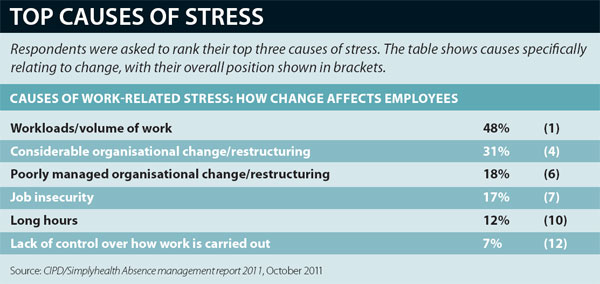Mergers and acquisitions can be a stressful time for employees, but an effective health and wellbeing strategy can help to ease the pressure
If you read nothing else, read this …
- Ensure communication is timely to avoid unnecessary anxiety and rumours.
- Keep employee assistance programme providers informed of any organisational changes and the products and procedures that are in place to provide extra support.
- Rebranding and relaunching a health and wellbeing strategy after a period of change can show that an organisation cares for its employees.
- Find staff to be health champions because peer infl uence can help to drive change.
Mergers and acquisitions can cause considerable upheaval for both employers and employees. While the business focuses on restructuring to move forward, staff can often be left anxious over the changes.
Stephen Mork, principal, global compensation and benefits at Buck Consultants, says: “The scariest thing is the unknown. If employees are unsure what is happening, they will assume the worst. Even if something bad is happening, tell them what you can to reduce rumours.”
Communications may need to include trade unions, and Mork recommends bringing together a team of people representing both merging organisations.
As well as keeping staff communication channels open during times of change, an employee assistance programme (EAP) can enable workers to talk through any concerns.
Even if there is already an EAP in place, it is worth reminding staff that it is available. Mandy Rutter, senior clinical business manager at Validium, says: “Employees often believe EAPs are there to deal with stress, so underline the fact that they can provide support for other things, including financial and legal problems.
“And, if you are going through change, tell the EAP provider what is happening. It will be able to refer employees to other resources you may have, so the support is joined up.”
Role of line managers
As well as using an EAP to support all employees, its services can be targeted at line managers, too. Sue Weir, chief executive of Medicash, says it is worth considering a managerial-level EAP to give access to training.
“Line managers play a critical role,” she says. “Giving them access to this type of service can enhance their confidence when handling crisis situations and human emotion in the workplace. In turn, this fi lters down and supports the culture of the organisation.”
Having line managers trained to deal with these situations can be particularly important after a merger, when staff may be adapting to changes in structure or increased workloads. Training can help line managers identify the early signs of stress and employees may feel more comfortable about seeking their help.
After the transition, employers will also need to assess how to move forward on health and wellbeing. Nick Boyton, principal at Alexander Forbes Healthcare and Risk, says: “Establishing a wellbeing strategy is a great way to tell employees you want to look after them.”
As well as weighing up the merits of the merging employers’ existing strategies and benchmarking them against the competition and the new organisation’s objectives, Boyton suggests speaking to employees. “If you can run focus groups or a survey to gauge what they want, you will get much greater engagement in the programme,” he says.
While attention must be paid to transfer of undertakings (protection of employment) (Tupe) as regards acquired employees’ terms and conditions, a health and wellbeing strategy can often sit on top of contractual benefi ts.
Relaunch health strategy
Once the dust has settled after a transaction, it is worth relaunching the health and wellbeing programme. Whether it is totally new or broadly the same as before, rebranding it can reinvigorate interest, says Elliot Hurst, director of health consulting at Axa PPP Healthcare. “Remind staff of the support you provide to help them achieve optimal health.”
New initiatives can also be added relatively cheaply. Ronjit Bose, commercial director at Jelf Employee Benefits, says: “Simple things can make a massive difference.” He recommends
low-cost options such as fresh fruit, bikes-for-work schemes, and walking and running groups. “Look to insurers too,” he says. “Many offer free services such as online health assessments and health information.”
To optimise employee engagement, Hurst recommends securing management buy-in by getting at least one person high up in the organisation to get involved with initiatives.
Alexander Forbes’ Boyton is also a big fan of engaging employees through their peers. “Health and wellbeing champions can create a strong local support structure and encourage employees to make changes,” he says.
Successful strategies need to be kept fresh. New or remarketed initiatives will engage staff, whatever the upheaval in the background.
Case study:
Chess makes decisive move for employee health
Business telecommunications provider Chess has about 180 employees. Established in 1993, it has grown significantly through a series of acquisitions.
Although this growth has been positive for the business, Anne Binnie, HR and compliance director at Chess, recognises that this changing environment, coupled with the tough economic climate,
makes it even more important to provide a healthy workplace. “We believe keeping our employees fit and well is an important contributory factor to our success,” she says. “Where staff come to us through acquisitions, it can be a time of uncertainty for them. We make sure they understand what we offer and how our health and wellbeing strategy supports them.”
Chess’s health and wellbeing strategy includes a variety of benefits, including massages, walking and running clubs, a bikes-for-work scheme, free flu jabs, organic fruit and support with smoking cessation.
Health insurance benefits include private medical insurance, dental insurance and a health cash plan. The cash plan, provided by Medicash, is particularly good at supporting employees, says Binnie. “It includes an employee assistance programme with face-to-face counselling where necessary, and also great benefits such as dental and health screening to keep our employees healthy.”
